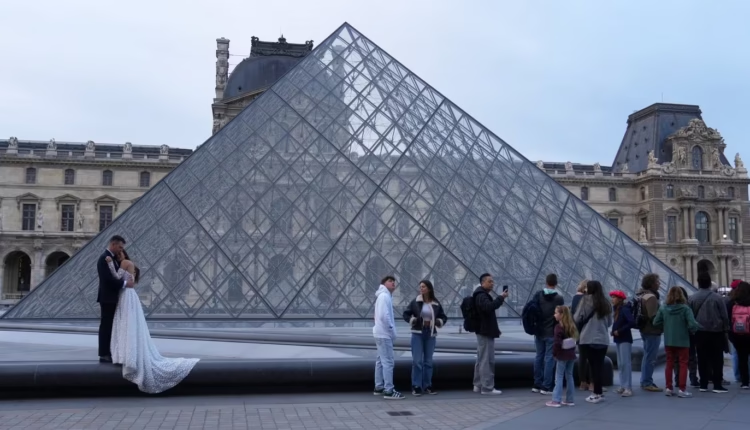The Louvre Heist: How the Theft of France’s Crown Jewels Became the Greatest Art Crime of the Century
It began like a scene from a perfectly orchestrated movie — only this time, it wasn’t fiction.
In the quiet hours of a Paris morning, under the soft gold glow of the Seine, a team of audacious thieves scaled the marble façade of the Louver Museum — home to the world’s most treasured artifacts — and vanished with a trove of France’s Crown Jewels worth over $100 million.
The Apollo Gallery, that glittering sanctuary of royal legacy, had been breached. Alarms shrieked, guards rushed, and yet — within mere minutes — history itself was stolen.
The Night of Shadows
According to investigators, the robbers used a construction basket lift, riding it like a silent serpent up the Louver’s centuries-old walls. Security footage — patchy, incomplete, and blind in key areas — captured only fragments of their movement: two masked silhouettes, a forced-open window, and the muffled crack of glass as they smashed display cases containing France’s royal gems.
Then, as if swallowed by the Paris mist, the thieves escaped — speeding off on two motorbikes into the labyrinth of narrow Left Bank streets.
By the time police arrived, the gallery floor was a storm of glitter and shattered glass. The only trace they left behind was Empress Eugénie’s emerald crown, dropped during their frantic getaway — a sparkling casualty of their haste.
A Heist that Awakened the World
The theft sent shockwaves across France and beyond.
For Parisians, it was a wound — not just to their museum, but to their soul.
For the rest of the world, it was fascination. Overnight, the Crown Jewels — relics that had lived quietly in the Louver’s golden halls — became global legends.
Art historians drew chilling parallels with the 1911 theft of the Mona Lisa, when a simple museum worker lifted da Vinci’s masterpiece from the wall, unknowingly catapulting it to eternal fame.
History, it seemed, had repeated itself. Because of the drama, the scandal, the heist — the Apollo Gallery itself will now become an icon,” said Anya Firestone, a Paris art historian. “Just as the Mona Lisa did after 1911.”
From New York to Tokyo, every major network aired the story. In a single night, the Louver’s lost jewels had achieved what decades of exhibitions never could: immortality through infamy.
The Ghosts of Empire
The jewels were not just ornaments; they were storytellers. Each gem was a page from France’s royal diary — diamonds that once adorned Marie-Amélie, sapphires that crowned Napoleon’s empress, and emeralds that gleamed under the candlelight of the Bourbon court.
Their theft, said Interior Minister Laurent Nuñez, was “an immeasurable loss — a fracture in the timeline of our civilization.”
Inside the museum, the air was heavy with grief. The Apollo Gallery, usually alive with tourists and schoolchildren, now stood sealed, silent — a crime scene under dim blue lights.
Yet even sealed off, it drew more visitors than before. People gathered just to see where it happened — to stare at the barricades, to feel the ghost of what once was.
I came to see the emptiness,” said Tobias Klein, a young architecture student. “It’s eerie — like the jewels themselves are haunting the room.”
The Paradox of Fame
Ironically, the robbery may have gifted the Louver something it never planned — a new legend.
Just as the Mona Lisa became the face of art after her disappearance, the Crown Jewels of France are now whispered about with awe, mystery, and superstition.
One relic — Empress Eugénie’s emerald crown, cracked but intact — has already become the museum’s most sought-after attraction.
Tourists call it “the crown that refused to leave.”I’d never even heard of it before,” said Mateo Ruiz, a visitor from Seville. “Now it’s the first thing I want to see.”
Inside the Investigation
Louver director Laurence des Cars called it a “terrible failure.” In a tense Senate hearing, she revealed that the museum’s exterior surveillance had fatal blind spots. No cameras were covering the exact point of entry.
She offered her resignation; the culture minister refused, calling her “a guardian of the nation’s soul.”
Still, the Louver’s vulnerabilities had been laid bare — chronic understaffing, overworked guards, and unchecked crowds numbering 33,000 visitors a day.
Authorities believe the gang had inside knowledge — possibly tipped off by contractors who worked on the museum’s renovation.
A police source described it as “precision-level work — not amateurs, not thrill-seekers. Professionals.”
The New Legend of the Louver
Now, the world waits — for the jewels, for justice, for answers.
But something strange is happening. As the investigation deepens, so does the mystique.
Like the Mona Lisa’s sly smile, the missing jewels have become an enigma that refuses to fade.
Artists, writers, and filmmakers are already circling the story — Netflix and French studios reportedly developing heist dramas inspired by the event.
And in that twist of irony, France’s heartbreak may become its newest myth.
The empty displays of the Apollo Gallery now gleam with something intangible — the allure of loss, the glamour of the forbidden, and the undying magnetism of mystery.
Because in the Louver’s long history, one truth remains unshaken:
Even in the absence, beauty has power.

